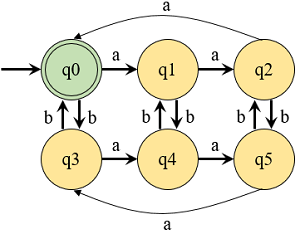A Novel Approach to Construct Finite Automata Using Grid and Product Automata
DOI:
https://doi.org/10.46604/aiti.2024.13599Keywords:
DFA, NFA, Grid, Product AutomataAbstract
This research aims to utilize an organized grid-based strategy to make the development of complex Finite Automata easier. Product Automata are used to merge many automata into a single automaton to integrate various computing processes. Combining these methodologies provides novel methods of improving the scalability and efficiency of automata building, broadening the field of research for automata theory and its applications. The scalability of this developed automated system will benefit sectors such as automotive production and logistics. The results indicate considerable improvements in construction time, memory usage, scalability, and resilience compared to older approaches. The performance of the developed method, as measured by construction time, memory utilization, scalability, robustness, application range, and complexity, is 25% to 50% higher than that of traditional methodologies in the literature.
References
X. Zhao, D. Shi, Y. Li, F. Qin, Z. Chu, and X. Yang, “Simulation of Dynamic Recrystallization in 7075 Aluminum Alloy Using Cellular Automaton,” Journal of Wuhan University of Technology-Mater. Sci. Ed., vol. 39, no. 2, pp. 425-435, April 2024.
O. Amir, A. Amir, A. Fraenkel, and D. Sarne, “On the Practical Power of Automata in Pattern Matching,” SN Computer Science, vol. 5, no. 4, article no. 400, April 2024.
A. Modanese and T. Worsch, “Embedding Arbitrary Boolean Circuits Into Fungal Automata,” Algorithmica, in press. https://doi.org/10.1007/s00453-024-01222-7
G. Pighizzini, L. Prigioniero, and S. Sadovsky, “Performing Regular Operations With 1-Limited Automata,” Theory of Computing Systems, vol. 68, no. 3, pp. 465-486, June 2024.
A. Maletti and A. T. Nasz, “Weighted Tree Automata With Constraints,” Theory of Computing Systems, vol. 68, no. 1, pp. 1-28, February 2024.
G. R. Laura, J. M. Francisco, G. S. Manuela, R. A. Pedro, and M. F. Víctor, “Cellular Automata Simulations of the Sintering Behavior of Ceramics Driven by Surface Energy Reduction,” Natural Computing, vol. 23, no. 1, pp. 69-70, March 2024.
P. Kishore, N. Thaduru, and K. K. Srinivas, “Design of High Performance Adders Using Quantum Dot Cellular Automata (QCA),” 14th International Conference on Computing Communication and Networking Technologies, pp. 1-6, July 2023.
B. Shahid, A. U. Rehman, N. Tahir, and O. Sattar, “Active Strategy for Learning Non-Deterministic Automata by Peer,” International Conference on Business Analytics for Technology and Security, pp. 1-7, March 2023.
V. Jaiswal and T. N. Sasamal, “A Novel Approach to Design Multiplexer Using Magnetic Quantum-Dot Cellular Automata,” IEEE Embedded Systems Letters, vol. 15, no. 3, pp. 133-136, September 2023.
V. Havlena, P. Matousek, O. Rysavy, and L. Holík, “Accurate Automata-Based Detection of Cyber Threats in Smart Grid Communication,” IEEE Transactions on Smart Grid, vol. 14, no. 3, pp. 2352-2366, May 2023.
P. Battyányi, T. Mihálydeák, and G. Vaszil, “Rough-Set-Like Approximation Spaces for Formal Languages,” Journal of Automata, Languages and Combinatorics, vol. 27, no. 1-3, pp. 79-90, 2022.
R. Vogrin, R. Meolic, and T. Kapus, “Generating and Employing Witness Automata for ACTLW Formulae,” IEEE Access, vol. 10, pp. 9889-9905, 2022.
S. Krehlik, “n-Ary Cartesian Composition of Multiautomata With Internal Link for Autonomous Control of Lane Shifting,” Mathematics, vol. 8, no. 5, article no. 835, May 2020.
M. Dutta, S. Kalita, and H. K. Saikia, “Cartesian Product of Automata,” Advances in Mathematics: Scientific Journal, vol. 9, no. 10, pp. 7915-7924, 2020.
M. Novak, S. Krehlik, and D. Stanek, “n-Ary Cartesian Composition of Automata,” Soft Computing, vol. 24, no. 3, pp. 1837-1849, February 2020.
X. Yu, W. C. Feng, D. Yao, and M. Becchi, “O3FA: A Scalable Finite Automata-Based Pattern-Matching Engine for Out-Of-Order Deep Packet Inspection,” Proceedings of the 2016 Symposium on Architectures for Networking and Communications Systems, pp. 1-11, March 2016.
S. Zekraoui, N. Espitia, and W. Perruquetti, “Finite-Time Estimation of Second-Order Linear Time-Invariant Systems in the Presence of Delayed Measurement,” International Journal of Robust and Nonlinear Control, vol. 33, no. 15, pp. 8951-8976, October 2023.

Published
How to Cite
Issue
Section
License
Copyright (c) 2024 Rupam Nag, Dibyendu Barman, Abul Hasnat

This work is licensed under a Creative Commons Attribution-NonCommercial 4.0 International License.
Submission of a manuscript implies: that the work described has not been published before that it is not under consideration for publication elsewhere; that if and when the manuscript is accepted for publication. Authors can retain copyright in their articles with no restrictions. is accepted for publication. Authors can retain copyright of their article with no restrictions.
Since Jan. 01, 2019, AITI will publish new articles with Creative Commons Attribution Non-Commercial License, under The Creative Commons Attribution Non-Commercial 4.0 International (CC BY-NC 4.0) License.
The Creative Commons Attribution Non-Commercial (CC-BY-NC) License permits use, distribution and reproduction in any medium, provided the original work is properly cited and is not used for commercial purposes.







